Understanding the nuances of table turnover is pivotal to your restaurant's smooth functioning and profitability.
If neglected, it could mean missed revenue opportunities, unhappy customers, and a lower chance of success.
For this reason, we made this guide to bridge any knowledge gaps regarding table turnover and aid you in optimizing your restaurant's operations effectively.
We delve into key aspects of this concept, shedding light on its importance, industry norms, ways to calculate your table turnover, and methods to enhance it.
So, buckle up as we take you on a journey to better understand the underpinnings of a thriving restaurant through the art and science of table turnover.
What Is the Table Turnover Rate
Before we dive in, getting a firm grip on the concept of table turnover is crucial.
Even though table turnover is often tossed around in restaurant jargon, it can easily be mistaken for some related yet distinct concepts.
It's crucial to differentiate these concepts to ensure everything is clear and get the most out of this guide.
The image below highlights two concepts associated with, but not identical to, table turnover.
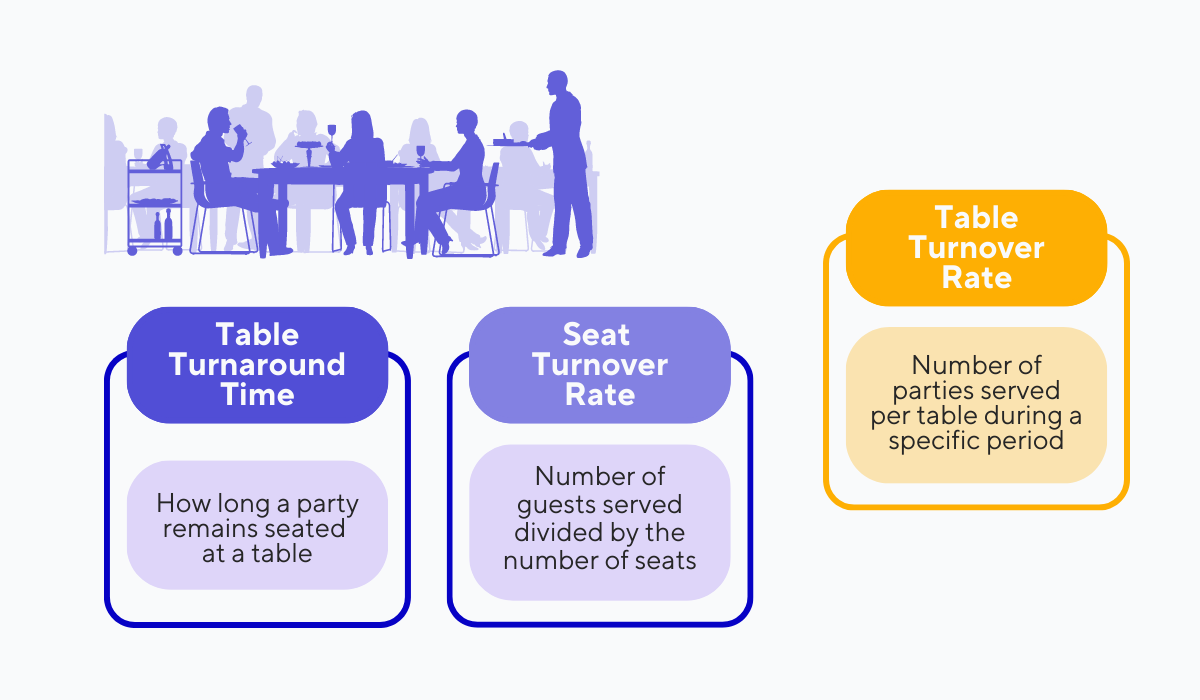
Source: Tablein
As the illustration indicates, turnaround time and seat turnover are two distinct terms.
Table turnaround refers to the total time a table is used, from when the guests are seated until they leave, while the seat turnover rate points toward how many times a particular seat is filled during a specific timeframe.
While both these concepts hold significance in the hospitality industry, we are focusing here on the table turnover rate. This rate quantifies the number of parties served per table during a specific period.
Let's look at the Quora explanation below from a former waitperson to provide a closer-to-home perspective.

Source: Quora
Table turnover is about managing the time guests spend at a table, so that you can accommodate more patrons, which translates into higher earnings for the restaurant and, potentially, more tips for the servers.
Understanding and actively monitoring your table turnover rate is vital for smooth operations.
A low turnover might signal inefficient service, while a high turnover might mean you're effectively utilizing your restaurant's capacity.
Overall, with a clear definition and an understanding of its importance now under your belt, you're well on your way to mastering this key metric. Let’s keep going.
What Is the Average Table Turnover Rate
While we're excited to delve into the nitty-gritty of calculating table turnover rates, let's first look at the industry standards, i.e., the average table turnover rate.
The ideal time before you turn a table, according to the data, is around 45 minutes.
This time was chosen because the average tip has been observed to increase with time spent, but only until the 40- to 50-minute mark.
Likewise, the meal costs also start to dwindle around the 30- to 40-minute mark.
However, this is an ideal number and achieving it involves a careful balance between maintaining a good dining experience for the guests and optimizing operations for maximum efficiency.
Bear in mind that, in reality, turnover heavily hinges on various factors, from your restaurant's capacity and the number and size of your tables to the type of restaurant you're operating.
A broad estimate, nonetheless, can be seen in the data illustrated below.
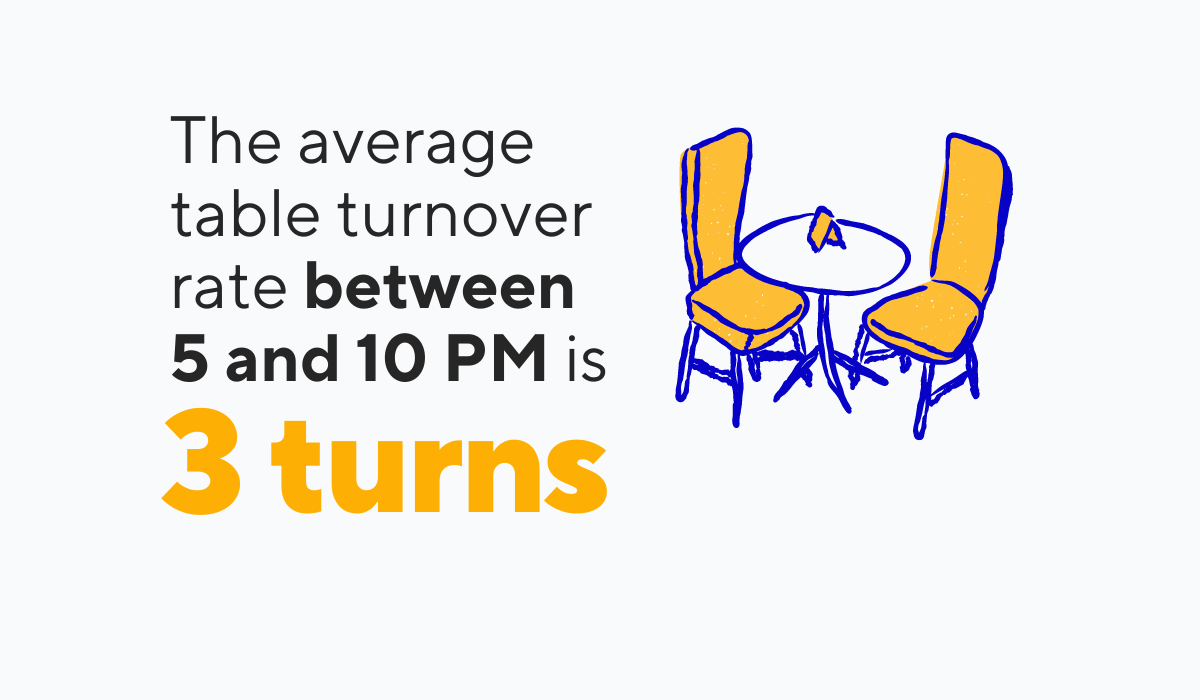
Illustration: Tablein / Data: Posist
The average turnover rate of three is typically calculated around dinner time or the peak hours when restaurants are usually bustling with activity.
Note that different time slots, like breakfast and lunch, might have different turnover rates.
Simply put, during dinner, tables usually flip every 1 to 2 hours, depending on the restaurant type. Check out the image below, showcasing how often a table is turned for three restaurant types.
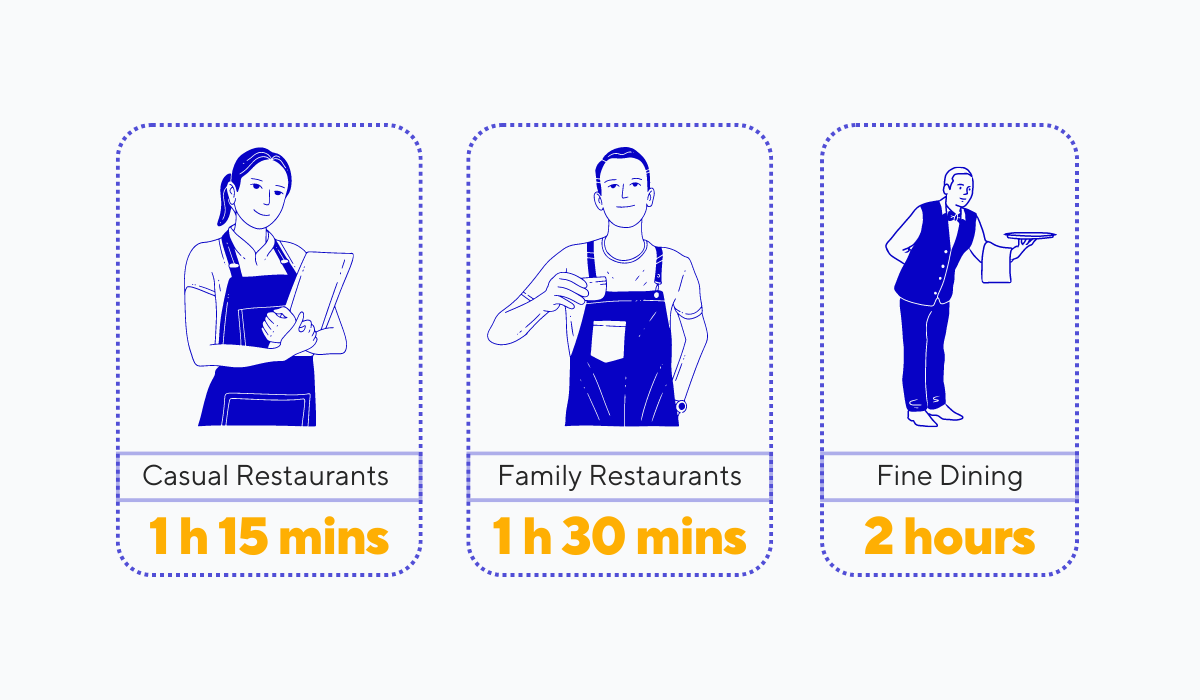
Illustration: Tablein / Data: Restaurant
Unsurprisingly, guests wouldn't normally occupy a table for more than 2 hours at a casual restaurant. Similarly, expecting a fine dining restaurant to flip tables every 1 hour is somewhat far-fetched.
Therefore, it is important to understand the nuances of your specific restaurant operations to aim for your optimal turnover rate.
How to Calculate Your Table Turnover Rate
And this aim is achieved by calculating your table turnover rate, which we will cover now.
You may already have a rough idea of how this process works. Or perhaps, you might already use some form of calculation within your operational framework.
But for clarity and consistency, let's cover this step-by-step, shall we?
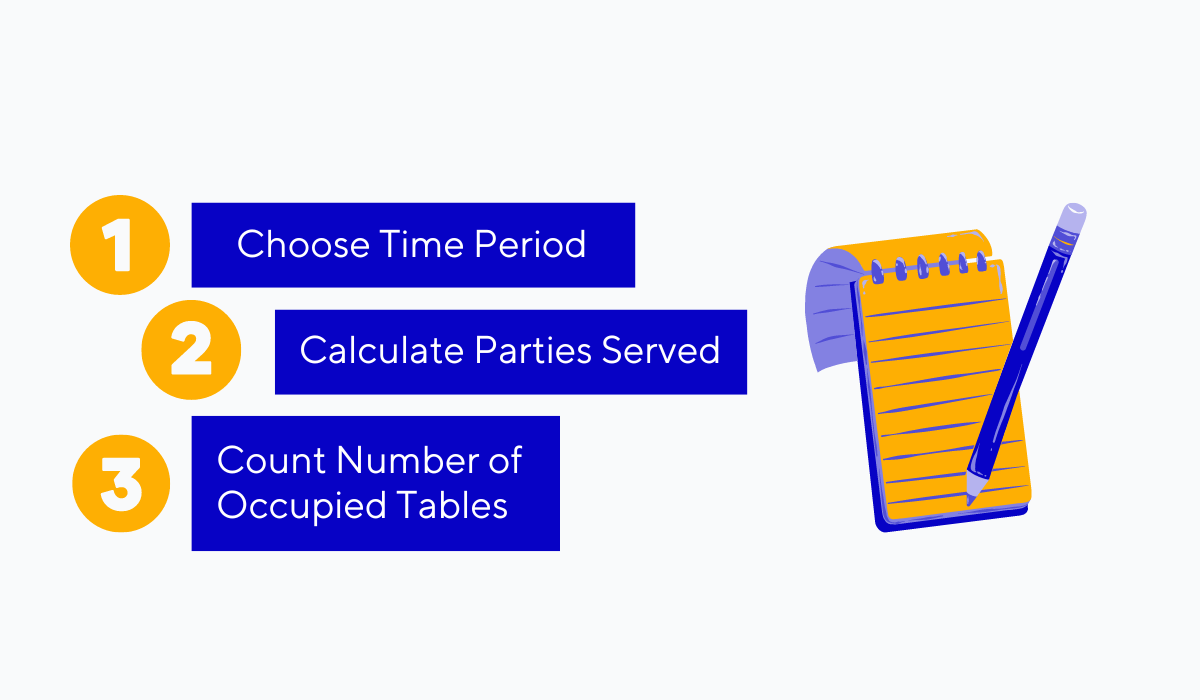
Source: Tablein
Pivotal to the entire process is the first step—determining the period for your calculation.
You can analyze your breakfast, lunch, and dinner turnover rates individually or calculate turnover throughout the whole day.
This stratified approach to tracking table turnover provides a wealth of information about your efficiency during each of these periods.
Next is calculating the number of parties you've catered to. This is where it is essential to encourage your staff to accurately track the number of parties they serve in your POS system.
Finally, account for the number of available tables used.
This process is not simply counting all the tables you own. If a table was unavailable or never occupied by guests, it's off the books for this calculation.
With these parameters in hand, you simply follow the formula depicted below.
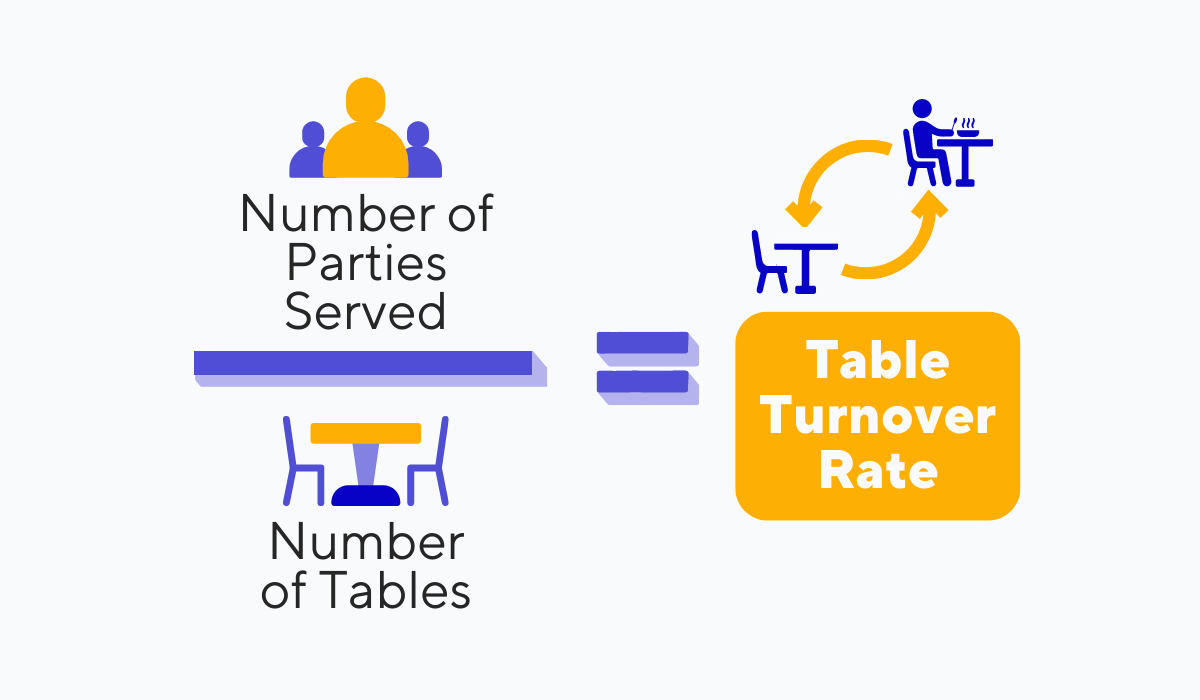
Source: Tablein
Divide the number of parties served by the number of available tables, and voilà, your turnover rate is calculated.
For a more hands-on understanding, let's look at a practical example shown in the following image.

Source: Quora
In other words, if you had 10 tables at your disposal and served 20 parties of 2, your calculation would be 20 divided by 10, yielding a turnover rate of 2.
This essentially implies that each table served two parties during the specified period.
To wrap things up, having a comprehensive understanding of how to calculate your table turnover rate is an indispensable asset in your restaurant management arsenal.
How to Maximize Your Table Turnover Rate
Now that you have all the vital information about industry averages and know how to compute your table turnover rate, you can see how your metrics compare with the norm.
Should your figures fall short of these standards, in this section we've got you covered with three strategies to boost your turnover rate.
But hey, even if you're acing those averages, there's always room for more, right? There's no such thing as too much success!
Let's first explore how you can use technology to flip tables even faster.
Use Restaurant Technology to Your Advantage
As the world gets increasingly digital, restaurant technology should not be ignored.
Modern reservation systems, POS systems, and other restaurant management software are not just fancy add-ons but are designed to streamline restaurant operations.
A significant part of this efficiency translates into improving table turnover rates.
Let’s illustrate our point by looking at how you can use Tablein, our very own reservation system, to your advantage.
One of the fundamental aspects of table turnover is the duration for which a guest occupies a table.
With this principle in mind, Tablein was crafted to include a feature where you can set the length of a reservation.

Source: Tablein
The default setting is 2 hours, but based on your restaurant type and personal preference, you can tweak it anywhere between 45 minutes to 6 hours. So, what's the magic behind this feature?

Source: Tablein
Look at the picture above, and you will notice that the reservation durations are displayed in the reservation list along with useful data like the number of guests.
This feature allows your staff to be aware of the time that guests have been at a table. Is the end time for a reservation nearing?
The staff can use this information to implement strategies to ensure guests don't overstay their welcome, all the while being polite and respectful.
You can even display these reservation durations on Tablein’s widget screen.

Source: Tablein
Guests can see your booking policy, along with the table limit before they even make a reservation.
This level of transparency helps set the right expectations, and many guests will adhere to the rules, knowing the time limit beforehand. It's all about making things clear, fair, and smooth for everyone.
By embracing modern tech like Tablein, you're well on your way to creating a more profitable and efficient restaurant.
Train Your Staff to Be More Efficient
Nothing beats the hustle and bustle of a well-organized, fast-paced restaurant. Let’s see how staff efficiency can make or break your table turnover rate.
One crucial way of increasing table turnover is by making your service a well-oiled and efficient machine. By streamlining your operations, you can avoid any unnecessary delay on your end.
After all, slow service means guests will occupy the table longer, leading to a longer wait time and a lower turnover rate.
For this reason, it's essential to set some service benchmarks for your staff, like the ones we outline below:
- Taking orders within 2-3 minutes of seating
- Avoiding needless back-and-forth trips to a table
- Preparing the check in advance and leaving it for guests as they finish their meal (without rushing them, of course)
- Clearing tables within 1-2 minutes after guests leave
Staff training plays a pivotal role in ensuring these benchmarks are met. You’d do well to create a staff training program or a restaurant operations manual that covers the following areas.

Source: Tablein
Waitstaff should be trained to take orders efficiently, be familiar with the menu, understand customer requirements, and anticipate their needs.
On the other hand, kitchen staff should focus on quick and accurate meal preparation and service.
Each staff member should be proficient with the technology they use, be it a traditional or mobile POS system or a table reservation system.
Even restaurant layout knowledge is essential. After all, a table may need the check, but if they are hidden from sight, and their server doesn't check up on them, they could occupy the table for hours.
By focusing on these training aspects, you can ensure your staff is as efficient as possible and help you increase your turnover rates.
Encourage Lingering Guests to Leave the Table
Alright, let's wrap things up by looking at the part your guests play in the turnover process.
The biggest speed bump you might hit when it comes to efficient table turnover is having to deal with lingering guests.
These folks stay glued to their seats long after the plates are empty, and the coffee cups are drained.
And while we could easily point the finger at these guests, the reality is that lingering is sometimes inevitable.
A pleasant conversation here, a cozy ambiance there, and before you know it, your guests have been occupying your tables for hours.
This lingering can pose a problem not only to your turnover rates but also to the overall experience of other diners waiting for a table.
The image below shows the personal experience of a guest with guests that won’t budge off their table.

Source: Quora
As you can see, even a single guest can cause inconvenience for other parties, even if they have a reservation at the establishment.
The silver lining is that many of these lingering situations can be prevented or curtailed by your diligent staff.
There are a few tactics your team can use to nudge lingering guests toward the exit without making them feel rushed or unwelcome. Let's have a look at them.

Source: Tablein
First off, a polite farewell can often do the trick. A simple closing statement like "We truly enjoyed serving you tonight. Looking forward to welcoming you back soon.
Have a good night!" can send the right signal without sounding rude.
However, if the guests are still glued to their seats, the waitstaff can start clearing the table. Seeing a clean, empty table can often nudge guests to wrap up their lingering.
A polite question like "Can I get you something else?" during the clearing process could be the nudge they need.
Lastly, if all polite nudges fail to hit the mark, you can consider incentivizing guests to vacate their tables.
Your team can courteously explain the situation and offer them an alternative spot at the bar with a complimentary drink or snack. It's a small price to pay for a new full-table order.
This tactic can create a win-win situation for everyone involved.
Through these approaches, you can manage lingering guests efficiently without compromising on the dining experience.
It's a delicate dance, no doubt, but these techniques will ensure a smoother table turnover and maintain a pleasant dining atmosphere for everyone involved.
Conclusion
We've covered a lot of ground in this article, tackling the fundamentals of table turnover and its relevance, and dived into strategies to leverage it effectively.
We sincerely hope this information was both enlightening and helpful.
Now, you’re not just more knowledgeable on this topic but equipped with actionable insights to fine-tune your restaurant operations, enhancing your customer experience and driving more profits.
Remember, the more efficiently tables are turned, the more guests are served, and the greater the rewards. So, take these newfound skills and start flipping tables—metaphorically, of course.
Get a 30-day Exclusive Trial
As a Tablein blog reader, you’re eligible for an exclusive 30-day free trial to experience our simple reservation solution for your restaurant.
Enter your business email, and we’ll send you all the steps needed to create your account.
Share this
You may also like

10 KPIs That Measure Your Restaurant's Efficiency

5 Restaurant Sales Metrics You Need to Be Tracking
